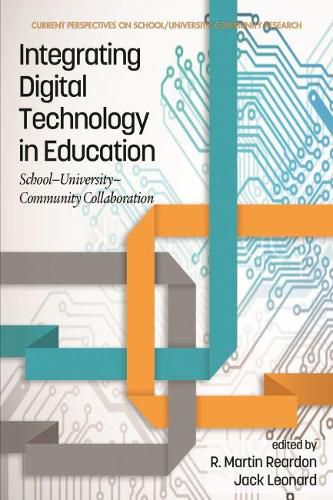Readings Newsletter
Become a Readings Member to make your shopping experience even easier.
Sign in or sign up for free!
You’re not far away from qualifying for FREE standard shipping within Australia
You’ve qualified for FREE standard shipping within Australia
The cart is loading…






This title is printed to order. This book may have been self-published. If so, we cannot guarantee the quality of the content. In the main most books will have gone through the editing process however some may not. We therefore suggest that you be aware of this before ordering this book. If in doubt check either the author or publisher’s details as we are unable to accept any returns unless they are faulty. Please contact us if you have any questions.
This fourth volume in the Current Perspectives on School/University/Community Research series brings together the perspectives of authors who are deeply committed to the integration of digital technology with teaching and learning. Authors were invited to discuss either a completed project, a work-in-progress, or a theoretical approach which aligned with one of the trends highlighted by the New Media Consortium’s NMC/CoSN Horizon Report: 2017 K-12 Edition, or to consider how the confluence of interest and action (Thompson, Martinez, Clinton, & Diaz, 2017) among school-university-community collaborative partners in the digital technology in education space resulted in improved outcomes for all-where all is broadly conceived and consists of the primary beneficiaries (the students) as well as the providers of the educational opportunities and various subsets of the community in which the integrative endeavors are enacted.
The chapters in this volume are grouped into four sections: Section 1 includes two chapters that focus on computational thinking/coding in the arts (music and visual arts); Section 2 includes three chapters that focus on the instructor in the classroom, preservice teacher preparation, and pedagogy; Section 3 includes four chapters that focus on building the academic proficiency of students; and Section 4 includes two chapters that focus on the design and benefits of school-university-community collaboration.
$9.00 standard shipping within Australia
FREE standard shipping within Australia for orders over $100.00
Express & International shipping calculated at checkout
This title is printed to order. This book may have been self-published. If so, we cannot guarantee the quality of the content. In the main most books will have gone through the editing process however some may not. We therefore suggest that you be aware of this before ordering this book. If in doubt check either the author or publisher’s details as we are unable to accept any returns unless they are faulty. Please contact us if you have any questions.
This fourth volume in the Current Perspectives on School/University/Community Research series brings together the perspectives of authors who are deeply committed to the integration of digital technology with teaching and learning. Authors were invited to discuss either a completed project, a work-in-progress, or a theoretical approach which aligned with one of the trends highlighted by the New Media Consortium’s NMC/CoSN Horizon Report: 2017 K-12 Edition, or to consider how the confluence of interest and action (Thompson, Martinez, Clinton, & Diaz, 2017) among school-university-community collaborative partners in the digital technology in education space resulted in improved outcomes for all-where all is broadly conceived and consists of the primary beneficiaries (the students) as well as the providers of the educational opportunities and various subsets of the community in which the integrative endeavors are enacted.
The chapters in this volume are grouped into four sections: Section 1 includes two chapters that focus on computational thinking/coding in the arts (music and visual arts); Section 2 includes three chapters that focus on the instructor in the classroom, preservice teacher preparation, and pedagogy; Section 3 includes four chapters that focus on building the academic proficiency of students; and Section 4 includes two chapters that focus on the design and benefits of school-university-community collaboration.